XXXXXXXXXXXXXXXXXXXXXXXXXXXXXXXXXXXXXXXXXXXXXXXXXXXXXXXXXXXXXXXXXXXXXXXXXXXXXXXXXXXXXXXXXXXXXXXXXXXXXXXXXXXXXXXXXXXXXXXXXXXXXXXXXXXXXXXXXXXXXXXXXXXXXXXX''"> 1.4 Composite Materials Construction
The Method menu for Composite materials contains the nine composite material models shown below.
Laminated Composite
The Laminated Composite option is used to compute the material properties of a laminate having, for each ply, an arbitrary constituent material, constant thickness, constant orientation and an optional global ply id for optimization. A laminate offset may also be specified. This is generally done when the neutral surface does not coincide with the middle surface. The offset is defined as the coordinate of the bottom of the stack relative to the neutral surface, which, by default, is the negative of half the laminate thickness.
Five Stacking Sequence Conventions are available for defining the layers. If there is no plane of symmetry, or global ply ids will be defined, then select the “Total” convention and define the attributes of all “n” layers of an n-ply stack. If the stack is symmetric or anti-symmetric with an even number of plies, select the appropriate convention and define the attributes of just the first n/2 layers. A (30,60,60,30) stack may be defined by selecting “Symmetric” and entering the angles “30 60" while a (30,60,-60,-30) stack may be defined by selecting “Anti-Symmetric” and entering the angles “30 60.” If the plane of symmetry passes through the center of a ply, use one of the “Mid-Ply” conventions and define the attributes of the first (n+1)/2 layers. A (45,90,45) stack may be defined by selecting “Symmetric/Mid-Ply” and entering the angles “45 90" while a (45,90,-45) stack may be defined by selecting “Anti-Symmetric/Mid-Ply” and entering the angles “45 90.” This last convention may be used with middle plies of arbitrary orientation to create laminates that are not truly anti-symmetric.
Global ply ids may only be entered when the Stacking Sequence Convention is “Total”. Attempts to enter them for other Stacking Sequence Conventions is not allowed.
Classical lamination theory is used to compute shell force-deformation properties. Other properties, including the elasticity matrix and the thermal expansion coefficients, are calculated using volume-weighted averaging. For more information on material property calculation, see
Theory - Composite Materials, 136.
Laminated Composite Form
This form contains a spreadsheet on which the composite ply material stacking sequence is defined. The spreadsheet can be loaded either by selecting ply materials from the Existing Materials listbox contained on the Materials application form or by entering a list of ply material names, thicknesses, orientation angles or global ply ids in the textbox on this form and selecting the Load Text Into Spreadsheet button, or by specifying the thickness for all layers of a given material in the lower databox. The user-selected cell determines where text is loaded into the spreadsheet. If in Overwrite mode, then the selected column is overwritten, starting with the selected cell, until the entries in the textbox are exhausted. If the entries exceed available space in the spreadsheet column, then a prompt will ask if additional rows are to be created. If in Insert mode, then new rows will be created just below the selected cell to accommodate the data in the textbox. If (as in the case at start-up) no rows exist, Insert mode is the default mode and entries in the textbox are loaded into the column specified by the switch on this form, starting at the first row.
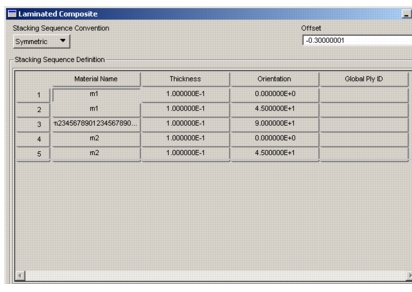
Stacking Sequence Convention | Select the convention that matches your laminate. Select “Total” if there is no symmetry plane, or if you will be assigning Global Ply IDs, in which case all layers must be defined in the spreadsheet. Symmetric and Anti-Symmetric laminates require only the bottom half of the stack. The “Mid-Ply” options are similar, except that the last specified layer in the spreadsheet is not assumed to be repeated (ie., “0 45” defines a 0/45/0 stack). If the convention is changed from “Total” and any non-blank Global Ply IDs exist, a warning will be issued and the option to clear all Global Ply IDs will be given. If declined, the convention will remain “Total”. |
Offset | Specify the laminate offset, which is the coordinate of the bottom of the stack relative to the neutral surface. If no offset is specified, Patran assumes that the middle surface is the neutral surface. |
Stacking Sequence Definition | Select a cell to set the insertion or overwrite starting point. Select a method of entry: Overwrite or Insert mode. To delete a row of cells, select a group of cells in a column and select the Delete Selected Rows button. If the Stacking Sequence Convention is not “Total”, cells in the Global Ply ID column may not be selected. Attempts to do so will fail and an informational message will be given. |
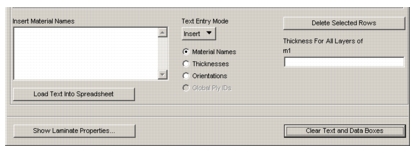
Insert Material Names | The textbox and its associated button, option menu and switch are strongly coupled to the spreadsheet. Enter strings of ply material names, thicknesses, orientation angles (in degrees) or global ply ids into the textbox. Then select the Load Text into Spreadsheet button to load the textbox contents into the spreadsheet. Entry starts at the selected cell (if in Overwrite mode) or just after it (if in Insert mode). The textbox title is determined by the settings of the associated option menu and buttons. This textbox accept shorthand. For example “-60,0,-60,0,-60,0” or “3(-60,0)” could both be used to enter the thicknesses shown above. To clear global ply ids cells enter “0” for the cell value. To clear a number of global ply ids enter “n(0)” where n is the number of rows to clear. |
Delete Selected Rows | Deletes the rows corresponding to any selected cells. |
Thickness for All Layers | Enter a value and hit <Return or Enter> to load that value into the spreadsheet Thickness column for all rows where the Material Name matches the one given over this databox. To change the name of this material (in order to assign thicknesses to a different material), select a spreadsheet cell containing the name of the desired material. This databox is not displayed until a ply material name is entered into the spreadsheet. |
Load Text Into Spreadsheet | Loads the contents of the textbox into the spreadsheet. |
Show Laminate Properties | Displays the Composite Material Properties form showing all stored properties of the material specified in the Material Name databox contained in the Materials Application form. |
Text Entry Mode | Determines whether textbox data are to be loaded into the Material Name, Thickness, Orientation or Global Ply ID columns. If any spreadsheet rows exist, a new cell will be highlighted in the appropriate column to indicate where data from the textbox are to be loaded. Global Ply IDs becomes inactive if the Stacking Sequence Convention is not “Total”. |
Clear Text and Data Boxes | Clears the textbox and the two databoxes. The spreadsheet is unaffected. |
Rule-of-Mixtures Composite
The Rule-of-Mixtures model is used to describe three-dimensional solids having an arbitrary number of material phases with arbitrary orientations and volume fractions. Orientations are defined for each phase using a triad of space-fixed rotation angles

in a 3-2-1 sequence. These angles rotate the composite material frame into the phase frame. The orientation of each phase is defined by starting with the phase frame aligned with the composite frame, and rotating the phase material frame

degrees about the 3-axis of the composite material frame, then rotating the phase frame

degrees about the 2-axis of the composite frame, and finally rotating the phase frame

degrees about the 1-axis of the composite frame.
Rule-of-Mixtures materials are, in general, fully anisotropic. All properties are calculated using volume-weighted averaging. The algorithms are described in
Rule-of-Mixtures Composite Materials, 141.
Rule-of-Mixtures Composites Form
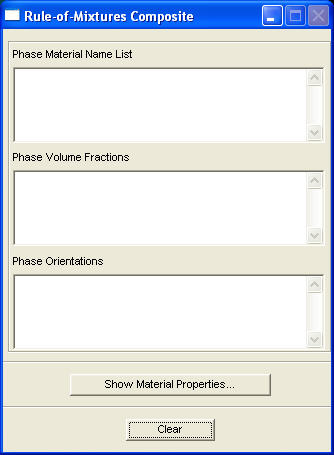
Phase Material Name List | Select phase materials by selecting their names in the Existing Materials listbox contained in the Materials application form. If the cursor is set in the Phase Material Name List textbox, then selecting a material in the Existing Materials listbox will cause that material name to be inserted at the cursor. Phase materials must have 3‑D material properties. |
Phase Volume Fraction | Specify the phase volume fractions corresponding to the phase materials specified in the Phase Material Name List textbox. The number of entries should be the same in both textboxes, but the last volume fraction may be omitted, in which case it will be assumed to be that value which would make the sum of all volume fractions unity. If the last volume fraction is not omitted, then the sum of the volume fractions must be unity. |
Phase Orientations | Specify the phase orientations corresponding to the phase materials specified in the Phase Material Name List textbox. Phase orientations are defined using a triad of space‑fixed rotation angles  in a 3‑2‑1 sequence. These angles (in degrees) rotate the composite material frame into the phase frame. The number of angles entered in the Phase Orientations textbox must therefore be three times the number of materials in the Phase Material Name List textbox. The first three angles are the first triad, the second three angles are the second triad, and so on. It is not necessary to group the angles with brackets or parentheses; simply input the sequence of angles separated by spaces. |
Show Material Properties | Displays the Composite Material Properties form showing all stored properties of the material specified in the Material Name databox contained in the Materials application form. 2‑D material properties, such as the shell force‑deformation matrices [A], [B], and [D], which are not consistent with this 3‑D material option, always have displayed values of zero. |
Clear | Clears all information from the three textboxes on this form. |
Halpin-Tsai Continuous Fiber Composite
The Halpin-Tsai Continuous Fiber model is used to describe 2-phase composites in which the matrix phase is isotropic and the fibers are uniform, continuous, cylindrical, and transversely isotropic. The resulting composite is therefore transversely isotropic. The Halpin-Tsai relations are used to calculate

, from which the remaining elastic constants can be determined. Some earlier versions of Patran calculated

instead of

, so this option is provided for compatibility. Only the names of the material constituents and their respective volume fractions are required input. The volume fractions provide default empirical factors for the Halpin-Tsai equations. If Halpin-Tsai relations are not desired the Override Default Equations toggle may be selected and empirical factor may be entered for each of the five elastic constants. See the Halpin-Tsai material model discussion in
Halpin-Tsai Composite Materials, 144 for the implementation of these constants in the Halpin-Tsai equations.
The Halpin-Tsai Continuous Fiber model expects a transversely isotropic fiber material and an isotropic matrix material. Warning messages will occur if this is not the case. Patran will ignore any additional properties that those materials may have and use the minimum number required to create a transversely isotropic composite material. It is, therefore, possible to use fully anisotropic fiber and matrix materials to create a transversely isotropic material. Physically, this makes no sense, so be careful if the warning message should appear.
Continuous Fiber Composite Form
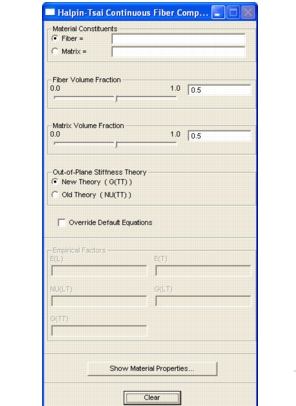
Material Constituents | Select the fiber and matrix materials by clicking on their names in the Existing Materials listbox contained in the Materials application form. The switch, which you can set, determines whether the selected material goes into the Fiber listbox or the Matrix listbox. |
Fiber Volume Fraction | Use either the slide bars or the databoxes to set the Fiber Volume Fraction and the Matrix Volume Fraction. The two parameters are coupled so that their sum cannot exceed one. Sums less than one are permitted (but not recommended) for modeling voids. |
Override Default Equations | Enable the five Empirical Factors databoxes. |
Empirical Factors | If enabled, enter five Empirical Factors used to calculate the corresponding composite elastic constants. The implementation of these constants is described in Halpin-Tsai Composite Materials, 144. |
Show Material Properties | Displays the Composite Material Properties form showing all stored properties of the material specified in the Material Name databox contained in the Materials application form. 2‑D material properties such as the shell force‑deformation matrices [A], [B], and [D], which are not consistent with this 3‑D material option, always have displayed values of zero. |
Clear | Clears all information from the two Material Constituent databoxes and the five Empirical Factors databoxes. |
Halpin-Tsai Discontinuous Fiber Composite
The Halpin-Tsai Discontinuous Fiber model is used to describe 2-phase composites in which the matrix phase is isotropic and the fibers are uniform, discontinuous, cylindrical, and transversely isotropic. The resulting composite is therefore transversely isotropic. The Halpin-Tsai relations are used to calculate

, from which the remaining elastic constants can be determined. Only the names of the material constituents, their respective volume fractions, and the fiber aspect ratio are required input. The volume fractions and fiber aspect ratio provide default empirical factors for the Halpin-Tsai equations. If the default Halpin-Tsai relations are not desired the Override Default Equations toggle may be selected and empirical factor may be entered for each of the five elastic constants, in which case, the fiber aspect ratio is no longer required. See the
Halpin-Tsai material model discussion in
Halpin-Tsai Composite Materials, 144 for the implementation of these constants in the Halpin-Tsai equations.
The Halpin-Tsai Discontinuous Fiber model expects a transversely isotropic fiber material and an isotropic matrix material. Warning messages will occur if this is not the case. Patran will ignore any additional properties that those materials may have and use the minimum number required to create a transversely isotropic composite material. It is, therefore, possible to use fully anisotropic fiber and matrix materials to create a transversely isotropic material. Physically, this makes no sense, so be careful if the warning message should appear.
Halpin-Tsai Discontinuous Fiber Composite Form
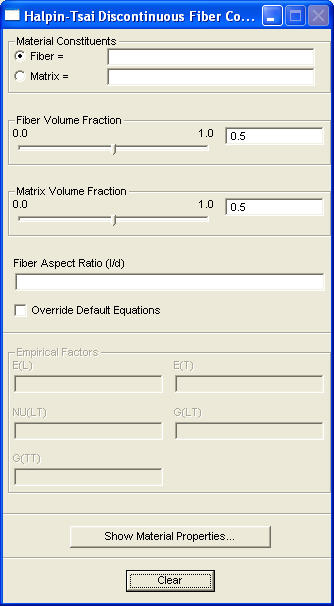
Material Constituents | Select the fiber and matrix materials by selecting their names in the Existing Materials listbox contained in the Materials application form. The switch, which you can set, determines whether the selected material goes into the Fiber listbox or the Matrix listbox. |
Fiber Volume Fraction | Use either the slide bars or the databoxes to set the Fiber Volume Fraction and the Matrix Volume Fraction. The two parameters are coupled so that their sum cannot exceed one. Sums less than one are permitted (but not recommended) for modeling voids. |
Override Default Equations | Enable the five Empirical Factors databoxes. |
Empirical Factors | If enabled, enter five Empirical Factors used to calculate the corresponding composite elastic constants. The implementation of these constants is discussed in Halpin-Tsai Composite Materials, 144. |
Show Material Properties | Displays the Composite Material Properties form showing all stored properties of the material specified in the Material Name databox contained in the Materials application form. 2‑D material properties, such as the shell force‑deformation matrices [A], [B], and [D], which are not consistent with this 3‑D material option, always have displayed values of zero. |
Clear | Clears all information from the two Material Constituent databoxes, the Fiber Aspect Ratio databox, and the five Empirical Factors databoxes. |
Halpin-Tsai Continuous Ribbon Composite
The Halpin-Tsai Continuous Ribbon model is used to describe 2-phase composites in which the matrix phase is isotropic and the fibers (or ribbons) are uniform, continuous, orthotropic, and have rectangular cross sections. The resulting composite is therefore orthotropic. The Halpin-Tsai relations are used to calculate

from which the remaining elastic constants are determined. Only the names of the material constituents, their respective volume fractions, and the fiber (or ribbon) aspect ratio are required input. The volume fractions and fiber aspect ratio provide default empirical factors for the Halpin-Tsai equations. If the default Halpin-Tsai relations are not desired, the Override Default Equations toggle may be selected and empirical factor may be entered for each of the six elastic constants, in which case the fiber aspect ratio is no longer required. See the Halpin-Tsai material model discussion in
Halpin-Tsai Composite Materials, 144 for the implementation of these constants in the Halpin-Tsai equations.
The Halpin-Tsai Continuous Ribbon model expects an orthotropic fiber (or ribbon) material and an isotropic matrix material. Warning messages will occur if this is not the case. Patran will ignore any additional properties that those materials may have and use the minimum number required to create an orthotropic composite material. It is, therefore, possible to use fully anisotropic fiber and matrix materials to create an orthotropic material. Physically, this makes no sense, so be careful if the warning message should appear.
Halpin-Tsai Continuous Ribbon Composite Form
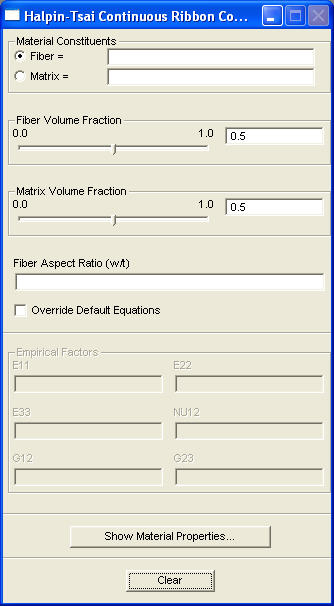
Material Constituents | Select the fiber (or ribbon) and matrix materials by selecting their names in the Existing Materials listbox contained in the Materials application form. The switch, which you can set, determines whether the selected material goes into the Fiber listbox or the Matrix listbox. |
Fiber Volume Fraction | Use either the slide bars or the databoxes to set the Fiber (or ribbon) Volume Fraction and the Matrix Volume Fraction. The two parameters are coupled so that their sum cannot exceed one. Sums less than one are permitted (but not recommended) for modeling voids. |
Override Default Equations | Enable the five Empirical Factors databoxes. |
Empirical Factors | If enabled, enter six Empirical Factors used to calculate the corresponding composite elastic constants. The implementation of these constants is discussed in Halpin-Tsai Composite Materials, 144. |
Show Material Properties | Select to display the Composite Material Properties form showing all stored properties of the material specified in the Material Name databox contained in the Materials application form. 2‑D material properties, such as the shell force‑deformation matrices [A], [B], and [D], which are not consistent with this 3‑D material option, always have displayed values of zero. |
Clear | Select this button to clear all information from the two Material Constituent databoxes, the Fiber Aspect Ratio databox, and the six Empirical Factors databoxes. |
Halpin-Tsai Discontinuous Ribbon Composite
The Halpin-Tsai Discontinuous Ribbon model is used to describe 2-phase composites in which the matrix phase is isotropic and the fibers (or ribbons) are uniform, discontinuous, orthotropic, and have rectangular cross sections. The resulting composite is therefore orthotropic. The Halpin-Tsai relations are used to calculate

, from which the remaining elastic constants are determined. Only the names of the material constituents, their respective volume fractions, and the fiber (or ribbon) aspect ratios are required input. The volume fractions and fiber aspect ratios provide default empirical factors for the Halpin-Tsai equations. If the default Halpin-Tsai relations are not desired the Override Default Equations toggle may be selected and empirical factor may be entered for each of the five elastic constants, in which case the fiber aspect ratios are no longer required. See the Halpin-Tsai material model discussion in
Halpin-Tsai Composite Materials, 144 for the implementation of these constants in the Halpin-Tsai equations.
The Halpin-Tsai Discontinuous Ribbon model expects an orthotropic fiber (or ribbon) material and an isotropic matrix material. Warning messages will occur if this is not the case. Patran will ignore any additional properties that those materials may have and use the minimum number required to create an orthotropic composite material. It is, therefore, possible to use fully anisotropic fiber and matrix materials to create an orthotropic material. Physically, this makes no sense, so be careful if the warning message should appear.
Halpin-Tsai Discontinuous Ribbon Composite Form
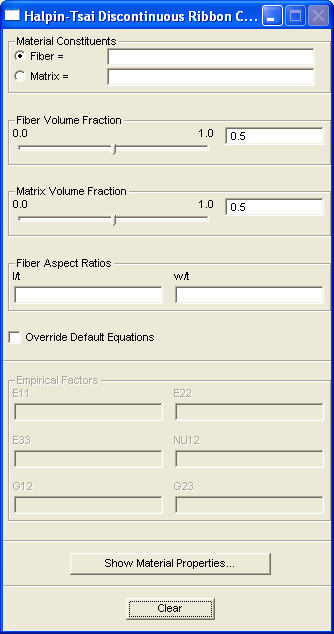
Material Constituents | Select the fiber and matrix materials by selecting their names in the Existing Materials listbox contained in the Materials application form. The switch, which can be set, determines whether the selected material goes into the Fiber listbox or the Matrix listbox. |
Fiber Volume Fraction | Use either the slide bars or the databoxes to set the Fiber Volume Fraction and the Matrix Volume Fraction. The two parameters are coupled so that their sum cannot exceed one. Sums less than one are permitted (but not recommended) for modeling voids. |
Override Default Equations | Enables the six Empirical Factors databoxes. |
Empirical Factors | If enabled, enter six Empirical Factors used to calculate the corresponding composite elastic constants. The implementation of these constants is discussed in Halpin-Tsai Composite Materials, 144. |
Show Material Properties | Displays the Composite Material Properties form showing all stored properties of the material specified in the Material Name databox contained in the Materials application form. 2‑D material properties, such as the shell force‑deformation matrices [A], [B], and [D], which are not consistent with this 3‑D material option, always have displayed values of zero. |
Clear | Clears all information from the two Material Constituent databoxes, the two Fiber Aspect Ratio databoxes, and the six Empirical Factors databoxes. |
Halpin-Tsai Particulate Composite
The Halpin-Tsai Particulate model is used to describe 2-phase composites in which both the particulate and the matrix phase are isotropic. The resulting composite is, therefore, isotropic. Common applications of the Particulate model include materials used in civil engineering applications, such as concrete. The Halpin-Tsai relations are used to calculate E and G, from which the remaining elastic constants can be determined. Only the names of the material constituents and their respective volume fractions are required input. The volume fractions provide default empirical factors for the Halpin-Tsai equations. If the default Halpin-Tsai relations are not desired, the Override Default Equations toggle may be selected and empirical factor may be entered for each of the six elastic constants. See the Halpin-Tsai material model discussion in
Halpin-Tsai Composite Materials, 144 for the implementation of these constants in the Halpin-Tsai equations.
The Halpin-Tsai Particulate model expects an isotropic particulate material and an isotropic matrix material. Warning messages will occur if this is not the case. Patran will ignore any additional properties that those materials may have and use the minimum number required to create an isotropic composite material. It is, therefore, possible to use fully anisotropic particulate and matrix materials to create an isotropic material. Physically, this makes no sense, so be careful if the warning message should appear.
Halpin-Tsai Particulate Composite Form
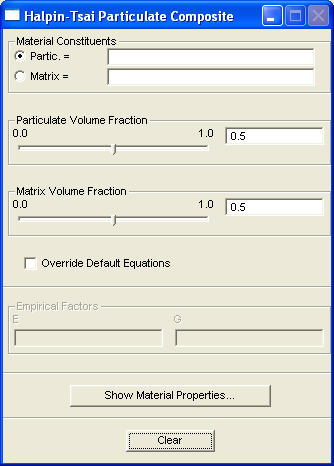
Material Constituents | Select the particulate and matrix materials by selecting their names in the Existing Materials listbox contained in the Materials application form. The switch, which you can set, determines whether the selected material goes into the Particulate listbox or the Matrix listbox. |
Fiber Volume Fraction | Use either the slide bars or the databoxes to set the Particulate Volume Fraction and the Matrix Volume Fraction. The two parameters are coupled so that their sum cannot exceed one. Sums less than one are permitted (but not recommended) for modeling voids. |
Override Default Equations | Enables the two Empirical Factors databoxes. |
Empirical Factors | If enabled, enter two Empirical Factors used to calculate the corresponding composite elastic constants. The implementation of these constants is discussed in Halpin-Tsai Composite Materials, 144. |
Show Material Properties | Displays the Composite Material Properties form showing all stored properties of the material specified in the Material Name databox contained in the Materials application form. 2‑D material properties such as the shell force‑deformation matrices [A], [B], and [D], which are not consistent with this 3‑D material option, always have displayed values of zero. |
Clear | Clears all information from the two Material Constituent databoxes and the two Empirical Factors databoxes. |
Short Fiber Composite (1D)
The 1D Short Fiber Composite model is used to compute the material properties of short fiber composites whose fiber orientation distributions can be described by a Gaussian curve. The user specifies a mean fiber orientation and a standard deviation to define the Gaussian (or normal) distribution.
A Monte Carlo integration scheme is used to sum the contributions of normally distributed “fibers” of a unidirectional material which should usually be a Halpin-Tsai Discontinuous Fiber material or a Halpin-Tsai Discontinuous Ribbon material. In other words, the geometrically appropriate Halpin-Tsai model is used to synthesize the properties of a unidirectional material having the same fiber material, matrix material, and fiber and matrix volume fractions as those of the short fiber composite to be created. The Short Fiber Composite model is then used to “distribute” the properties of the unidirectional Halpin-Tsai material within the specified Gaussian function. The material properties for each iterate are summed using the volume-weighted averaging methods used for Rule-of-Mixtures Composites. The default number of iterations is 1000, but it may be overridden to any positive integer. Scalar quantities, such as density, are simply assigned the same values as those of the constituent unidirectional material.
For more information on the algorithm, see
Short Fiber Composite Materials, 151.
Short Fiber Composite (1D) Form
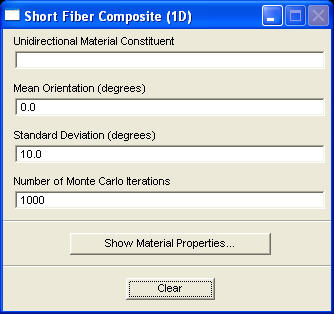
Unidirectional Material Constituents | Specify the Unidirectional Material Constituent by selecting its name in the Existing Materials listbox contained in the Materials application form. Constituent materials may have 2‑D or 3‑D material properties. |
Mean Orientation (degrees) | Specify the mean orientation of the fibers in polar coordinates. A mean orientation of 0 degrees means that the preferred fiber direction is toward the material frame 1‑axis, while a 90-degree mean tends to align the fibers with the 2‑axis. |
Standard Deviation (degrees) | Specify the standard deviation of the fiber distribution. It must be positive. |
Number of Monte Carlo Iterations | Select the number of Monte Carlo iterations used for the numerical integration of the unidirectional material properties. The default of 1000 is usually adequate, but any positive integer is acceptable. Avoid excessively large values which will only tie up the computer CPU needlessly. |
Show Material Properties | Displays the Composite Material Properties form showing all stored properties of the material specified in the Material Name databox contained in the Materials application form. Material properties such as the shell force‑deformation matrices [A], [B], and [D], which are not consistent with this material option, always have displayed values of zero. |
Clear | Clears the Unidirectional Material Constituent databox. |
Short Fiber Composite (2D)
The 2D Short Fiber Composite model is used to compute the material properties of short fiber composites whose fiber orientations can be described by a Gaussian surface. The user specifies mean fiber orientations and standard deviations, as well as a correlation coefficient, to define the Gaussian (or normal) distribution.
A Monte Carlo integration scheme is used to sum the contributions of normally distributed “fibers” of a unidirectional material which should usually be a Halpin-Tsai Discontinuous Fiber material or a Halpin-Tsai Discontinuous Ribbon material. In other words, the geometrically appropriate Halpin-Tsai model is used to synthesize the properties of a unidirectional material having the same fiber material, matrix material, and fiber and matrix volume fractions as those of the short fiber composite to be created. The Short Fiber Composite model is then used to “distribute” the properties of the unidirectional Halpin-Tsai material within the specified Gaussian function. The material properties for each iterate are summed using the volume-weighted averaging methods used for Rule-of-Mixtures Composites. The default number of iterations is 1000, but it may be overridden to any positive integer. Scalar quantities, such as density, are simply assigned the same values as those of the constituent unidirectional material.
The Unidirectional Material Constituent must have 3D properties defined. For more information on the algorithm, see
Short Fiber Composite Materials, 151.
Short Fiber Composite (2D) Form
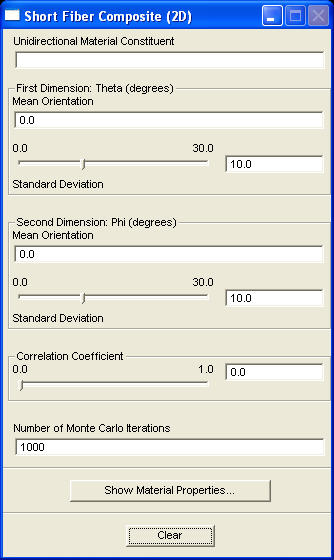
Unidirectional Material Constituents | Select the Unidirectional Material Constituent by selecting its name in the Existing Materials listbox contained in the Materials application form. Constituent materials must have 3‑D material properties. |
First Dimension: Theta (degrees) | Select the mean orientation and the standard deviation corresponding to the azimuthal angle  . See Short Fiber Composite Materials, 151 for a description of the spherical frame in which  is defined. Use either the slide bar or the databox to specify the standard deviation. The standard deviation must be positive and cannot exceed 30.0. |
Second Dimension: Phi (degrees) | Select the mean orientation and the standard deviation corresponding to the polar angle  . See Short Fiber Composite Materials, 151 for a description of the spherical frame in which  is defined. Use either the slide bar or the databox to specify the standard deviation. The standard deviation must be positive and cannot exceed 30.0. |
Correlation Coefficient | Use either the slide bar or the databox to define the Correlation Coefficient. The default value of zero is usually adequate. The Correlation Coefficient must be a nonnegative number less than one. |
Number of Monte Carlo Iterations | Select the number of Monte Carlo iterations used for the numerical integration of the unidirectional material properties. The default of 1000 is usually adequate, but any positive integer is acceptable. Avoid excessively large values which will only tie up the computer CPU needlessly. |
Show Material Properties | Displays the Composite Material Properties form showing all stored properties of the material specified in the Material Name databox contained in the Materials application form. 2‑D material properties, such as the shell force‑deformation matrices [A], [B], and [D], which are not consistent with this 3‑D material option, always have displayed values of zero. |
Clear | Clears the Unidirectional Material Constituent databox. |
Composite Material Properties
The Composite Material Properties form is displayed when the “Display” button on a Composite option-specific form is selected.
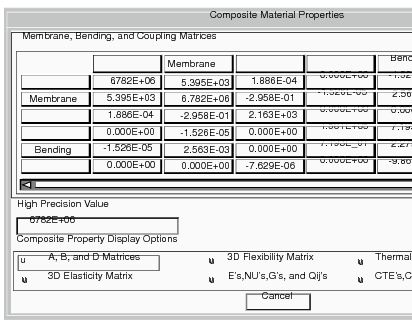
High Precision Value | Selecting any of the displayed values in the 6x6 spreadsheet causes that value to be displayed in greater precision in the databox. |
Composite Property Display Options | A, B, and D Matrices. The displayed 6 x 6 matrix relates the in‑plane force and moment vector {N 1,N 2,N 12,M 1,M 2,M 12} to the vector of midsurface strains and curvatures  in the expression where A, B, and D are symmetric 3x3 matrices. 3D Elasticity Matrix. The 3D Elasticity matrix relates the stresses  to the strains  in the expression: The Thermal and Moisture Expansion Coefficient vectors are displayed with the Density, Structural Damping Coefficient, Specific Heat, and Reference Temperature. |
| 3D Flexibility Matrix. The 3D Flexibility matrix relates the strains  to the stresses  in the expression: E’s, NU’s, G’s, and Qij’s Triads of E’s,  ’s, and G’s are presented, along with the plane stress Stiffness matrix [Q] relating the stresses  to the strains  in the expression: |
| Thermal: Kij, Ni, and Mi. The 3 x 3 Conductivity matrix Kij is shown with the Resultant Thermal Force and Moment vectors, Ni and Mi, respectively. CTE’s, CME’s and Others. The Thermal and Moisture Expansion Coefficient vectors are displayed with the Density, Structural Damping Coefficient, Specific Heat, and Reference Temperature. |











